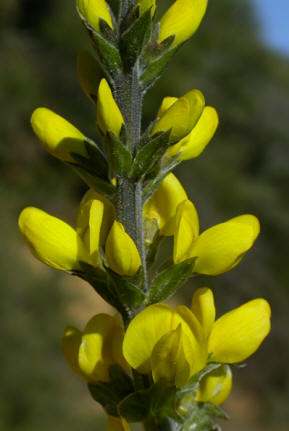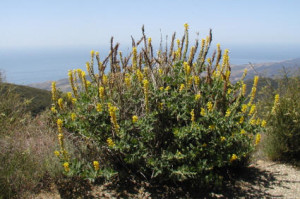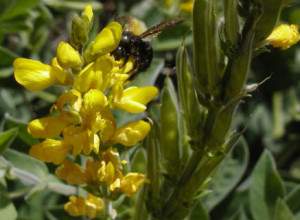Thermopsis macrophylla
- Sensitive – U.S. Forest Service
- Rare Plant Rank 1B.3 – California Native Plant Society
- G1 Critically Imperiled – NatureServe (1998)

Photo by Christopher Christie.
Santa Ynez false lupine — also know as the Santa Ynez goldenbanner — is one of the rarest plant species on the Los Padres National Forest. It is found nowhere else in the world, restricted to the Santa Ynez Mountains with only ten known growth patches along a narrow band between La Cumbre Peak and Santa Ynez Peak. While it is closely related to the California false lupine, it is genetically unique to only this area and is distinguished by its hairier stem and more dense flower clusters. It grows mostly in gravelly soils formed by Matilija sandstone deposits, and in chaparral habitat.
The “false lupine” is a botanical imposter, looking very much like true lupines, but not genetically related to them. It is a bush-like perennial plant (lives for many years) with long, flowering stalks and golden, pea-shaped flower clusters. It is also rhizomatous, meaning that its root system spreads out just beneath the surface and sends out shoots that form new plants. The Santa Ynez false lupine is the largest of all false lupines, with mature plants reaching over 3 feet wide and 6 feet tall when flowering, usually between April and June.
Wildfire and the False Lupine

Photo by Brent Miller.
Santa Ynez false lupine is also a unique plant in that it is very dependent on natural wildfire for reproduction. Its seeds accumulate in the soil and they are stimulated to grow by the heat produced by wildfire. Wildfire also clears an area of other plant species, allowing the Santa Ynez false lupine more room to establish as its heat-germinated seeds begin to grow. Fire suppression therefore could harm the species in two ways: firstly, without wildfire, new seeds do not germinate and grow; secondly, methods of fire suppression like clear-cutting chaparral areas may directly impact plants by removing them. Fuelbreak construction and maintenance along the Santa Ynez Mountain ridgeline continues to pose a threat to the survival of this unique plant.
Threats and Conservation Efforts
Other potential threats to Santa Ynez false lupine include road maintenance, illegal off-road vehicle use, and invasive non-native plants. The Forest Service is constructing a 40-mile long fuelbreak from Refugio Pass to Romero Saddle, and they have vowed to flag all Santa Ynez false lupine and protect them with a ten-foot buffer. ForestWatch is working to ensure that this protective measure is actually implemented, and to ensure that the survey is current and complete. A 15-mile network of illegal off-road vehicle trails on Camino Cielo also threatens this species.

A bee pollinates Santa Ynez false-lupine flowers (left), which will then become a stalk of seed pods (right). Photo by Brent Miller.
Santa Ynez false lupine is considered by the Forest Service to be “sensitive,” meaning that any number of activities could negatively impact its survival due to its extremely small populations and narrow distribution in the Santa Ynez Mountains. For this reason, the Forest Service and the Santa Barbara Botanic Garden have been working together to collect seeds from wild plants to be held in storage and cultivated at the Garden. In the case that the wild plants suffer large losses, these seeds and plants will be available to bolster the species in the wild.






